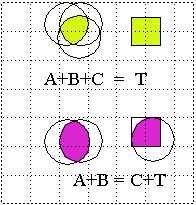
Computer Scientist’s wheel: 2D: Red, Green, Blue. ==> Additive mixing (light beams, CRT).
We are missing some colors: where is brown, olive, pink, dark blue ... ?
METAMERS: colors that look the same (P), but have different spectrum(L1,
L2).

Comparative measurements are done with a color-matching set-up:

3 superposed lights (A,B,C) are compared with test color (T).
You can match almost all, but not all, colors as far as human perception
goes.
The remainder can be matched when one of the 3 colors is placed on
the test light to produce a subtractive effect.
This results in color matching functions with positive and negative
coefficients.
==> Perceptual
space is 3-dimensional. (1st Grassmann Law )
1. Perceptual space is 3-dimensional.
(see above)
2. Metamer mix (add) to yield metamers:
L1, L1’ -> P1; L2, L2’ -> P2; then for any a, b :
a*L1 + b*L2 -> P3; then a*L1’ + b*L2’-> P3.
(not true for paints or pigments with non-additive behavior; see example
with filter below).

3. As physical color is varied continuously, perceptual color also
varies continuously.
(continuity of the perceptual process).
A perceptual
color space was formally defined in 1931 by the Commission International
de l’Eclairage (CIE).
To avoid the need for negative weights, they defined a new set of basis
vectors (primary colors) X, Y, Z,
that lie completely outside the range of all visible RGB values,
so that the color matching functions x(l),
y(l), z(l) for any
visible hue become entirely positive (Foley Fig.13.22).
In addition, the y(l) function is
defined so that it matches the luminosity-efficiency of the human eye (Foley
Fig.13.19);
thus it can be used by itself as an intensity channel.
The transformation from the original RGB color matching functions to
the CIE color matching functions is linear.
If we intersect the visible portion of the CIE color space with a plane
X+Y+Z=1 (about equal brightness),
then we get the horseshoe-shaped region depicted in the CIE
chromaticity diagram.
The fully saturated, pure, spectral colors all lie on the curved part
of the horseshoe.
Somewhere near the center is a point defined as "white".
Colors lying opposite this "white" point are called complementary
colors (Foley Fig.13.26).
A particular tri-stimulus
(3-color) display system has three primaries: I,J,K (Foley Fig.13.27).
It can display only the colors that lie within its convex hull (=triangle).
(Can only use linear combinations of the 3 base colors with coefficients [0,1]).
Thus we would like to make this triangle as large as possible (-> "ideal
basis"),
but we are limited by what colors of phosphor (or LED's, or gas-discharge)
are available.
The typical CRT display can cover less than half of the visible domain
of colors.